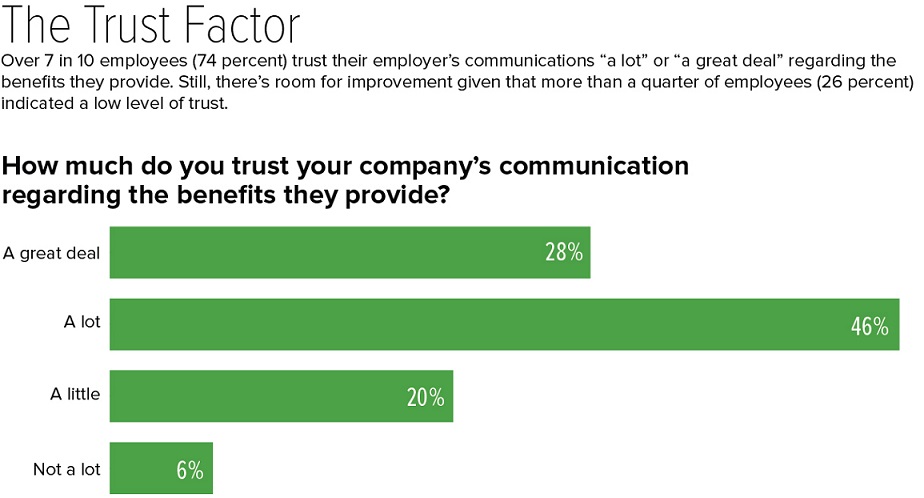Open Enrollment: Using Social Media and Decision-Support Tools
Technology is helping employees make wiser benefit decisions

This is the fourth in a series of articles about meeting open enrollment challenges. This article looks at the growing use of social media in benefits communications and providing automated guidance for selecting benefits.
Benefit managers are turning to social media to get the open enrollment message out and are providing access to decision-support tools to help employees select appropriate health plans and other benefits.
"Some companies use Twitter and Facebook to promote enrollment participation and to send information about benefit changes"—including Facebook's Workplace platform—"and see good results from it," said Andy Edeburn, director of customer insight at Jellyvision, an employee communication software provider based in Chicago. Others are turning to "internal social media platforms with a workforce bent, such as Yammer, that feel like social media but are definitely a work tool," he noted.
More companies are holding Twitter chats about a particular benefit topic, "with employees tweeting their questions and HR tweeting back responses," he said.
"We're noticing that employers are willing to get creative," said Meredith Ryan-Reid, senior vice president in insurance provider MetLife's group benefits division in New York City. "We used to hear, 'What am I obligated to do?' That has evolved into, 'How do we make this fun and interesting for people, how do we get their attention?' "
Many employers, however, remain cautious about using social media for open enrollment. "Some say they're hesitant because [not] all of their employees … have a computer. I tell them, 'Oh yes they do, and it's in their pocket," said Kim Buckey, vice president of compliance communications at Birmingham, Ala.-based DirectPath, an employee engagement and health care compliance firm. "If they don't have a laptop, they have a smartphone."
Most employees now have access to a self-service pay and benefits online portal, and more than 12 percent prefer to access it through their smartphones rather than a computer, according to American Payroll Association's 2017 Getting Paid In America survey. That figure is sure to keep growing.
"It's becoming more common for people to use their smartphones to shop for cars, do their taxes and even apply for mortgages," said Logan Butler, benefits content specialist at Benefitfocus, a benefits management IT firm. "If your employees can use their mobile devices for those traditionally complex processes, wouldn't it make sense for them to be able to use them to enroll in their benefits?" he noted. "They can open up an app or their device's mobile browser and begin a mobile-optimized enrollment experience, complete with plan recommendations [that draw on] integrated claims data. A few swipes and clicks later, and they're done."
[SHRM members-only toolkit: Managing Organizational Communication]
Getting Employee Input
Employers still underestimate their employees' use of social media, especially when it comes to older employees, Buckey said. Social media use "is more widespread than they think it is," she pointed out. These employers "need to ask their employees whether they would find communicating through social media to be helpful, and then do some test runs within a particular location or set of employees."
Whether employers are comfortable using social media for employee communications depends on the organization's culture, said Ryan-Reid. "Some companies use these channels as a primary form of employee communication and some don't, while others are in the early stages of doing so. Many would be happy to get away from the era of posters and brochures on cafeteria tables, and take a multimedia approach."
"Ask employees for help," concurred Bob Armour, chief marketing officer at Jellyvision. "Form a benefits communication task force composed of key groups of employees," based on factors such as age, location, and whether they are paid hourly or are salaried.
"Employers might want to provide employees with an incentive—such as the chance to win a raffle—if they follow your open enrollment Twitter or Facebook feeds," Armour suggested.
Texting, Too
Consider sending text messages with hyperlinks to the benefit materials and to the enrollment platform, Armour advised. "You can create and schedule text messages using inexpensive, cloud-based platforms, he noted. A few examples: EZ Texting, TellMyCell and TXT180.
Employers can also use "an old-fashioned, automated phone-call campaign, with calls placed before and during open enrollment—and after enrollment ends to solicit feedback," he advised. Examples of dialing platforms include VoiceLogic, Call Loop and RoboTalker.
Adding Video Messages
Using nontraditional communications such as video "is a great way to engage and inform employees" and makes it easier to reach those who don't work in a central office, said Christiana Lu, San Francisco-based director of benefit consulting at Namely, an HR, payroll and benefits platform.
The 2016 International Foundation of Employee Benefit Plans' Benefits Communication Survey Results found that among the 29 percent of employers that used videos to communicate about benefits, 70 percent reported their efforts were successful.
In addition, a 2017 study of employee benefits video response rates conducted by Houghton, Mass.-based Flimp Media found that:
- 78 percent of the more than 173,000 employees who received a video e-mail "postcard" related to benefits viewed the video at least once.
- 94 percent of the employees who viewed a video took some action after doing so, including logging into the online enrollment software and accessing benefits information.
Source: Jellyvision's 2017 ALEX Benefits Communications Survey, conducted in February and March 2017, based on responses from 2,043 U.S. adults employed full-time and eligible for company provided benefits. |
Decision-Support Tools
Along with new media, employers are turning to decision-support software to guide employees when selecting benefits.
If an employer is using a benefits administration platform, "it's important to provide guided selection that helps [employees] to make benefit choices," said Ryan-Reid.
"Employees are asked for some key information at the beginning of the process, so that your system—or a person who is on the phone with the employee—can access the employee's needs and make appropriate recommendations," she explained. "That's another dimension to customization."
However, "if you've made an investment in these tools and are not seeing the return you hoped for, it's likely due to a lack of education and communications," Buckey said. "While these tools are a great starting point, they can't address every individual situation, and not everyone is comfortable with the technology—at least not without help."
If employees don't understand the basics of how a benefit plan works, "then a plan comparison tool can be intimidating," she said. "That's where personal one-on-one support can help improve use of these tools."
Make tablets or laptops available so employees can try out digital tools, advised Mark Rader, benefits communication expert at Jellyvision. "A new benefits decision support tool or online enrollment platform can be intimidating," he noted. "If possible, get employees over their fears by showing up at their work site with tablets or laptops featuring those tools, so they can take them for a test drive with you beside them, helping out."
This is the fourth in a five-part series of articles on meeting open enrollment challenges. The previous installment is Open Enrollment: Targeted Communications Address Differing Needs. The fifth installment is Open Enrollment: Voluntary Benefits Emphasize Choice.
Also in this series:
Part One: Open Enrollment: Active vs. Passive Benefits Election
Part Two: Open Enrollment: Developing Your Game Plan
Related SHRM Resources:
Open Enrollment Guide & Resources Page
Was this article useful? SHRM offers thousands of tools, templates and other exclusive member benefits, including compliance updates, sample policies, HR expert advice, education discounts, a growing online member community and much more. Join/Renew Now and let SHRM help you work smarter.
An organization run by AI is not a futuristic concept. Such technology is already a part of many workplaces and will continue to shape the labor market and HR. Here's how employers and employees can successfully manage generative AI and other AI-powered systems.




